BOB AND NAOMI (Bethea) HUGHES
Composed and presented by R. R. (Bob) Hughes, June 1999.
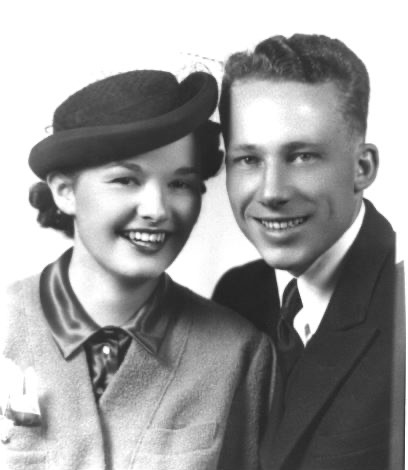
WEDDING PICTURE, AUGUST 1938
INTRODUCTION:
Since this web site is associated with our family genealogy site, and since genealogy concentrates on the male bloodline, I suppose that gives me the privilege of putting my name first and to tell my story first in this presentation. Realistically, it is our story, not my story. Accordingly, I am writing the following to give equal status, in spite of the genealogical system, to my partner and companion of more than 60 years
MY STORY:
I was born in rural, mountainous, western Montana, January 4th, 1915.
My understanding is that I was two weeks premature, heavy snow blocked the roads, the nearest neighbor was two miles up the road and my Dad was away on a freighting job. My mother and six-year-old brother, Edwin, managed to harness a team of horses and he drove a wagon to get the neighbor lady. I don't know when the Doctor arrived, or if he ever did. However, the neighbor was apparently a good midwife because I'm still here and my mother lived to the age of 92. (Twenty two years later the neighbor lady made an affidavit to the effect that she was present at my birth so that I could get a birth certificate.) I finished grade school and high school in Montana, going to Washington State in 1933 and attending the Bellingham Normal (now Western Washington University) for one school term. I dropped out of school for three years, working on the Fort Peck Dam (Montana) and in the Butte mines, then going back to the University of Washington in the fall of 1937.
MY ANCESTRY:
Click on Thomas Sievers Hughes, (1884-1964) for my father's history. Click on other links to see 300 years of Hughes genealogy and our family tree.)
My mother was born Emily Mackel, March 19, 1887, at Pleasant View, Norman County, Minnesota. Both of her parents were of German extraction. She was barely one year old when her father died, and the older brothers subsequently supported the large family. She was l6 years old when her mother died; and Emily went by train from Ada, Minnesota. to Butte, Montana. Her sister, Bertha, lived in Butte and Emily lived with Bertha; went to school and worked as secretary in her brother's (Alex) law office. Two other brothers, Joe and Tony, had a ranch in the Madison Valley and it was on a visit to them that she met my father. They were married in 1908 and lived the rest of their lives in the Madison Valley, raising a family of five and building a cattle ranch from practically nothing.
NAOMI'S STORY:
Naomi was born on a farm near Mt. Pleasant, Washington, September 2nd, 1918. Mt. Pleasant consisted of a store and post office on a steep hillside on the north bank of the Columbia River, a few miles upriver from Washougal. When Naomi was about two years old her parents purchased the Mt. Pleasant store and post office and they lived there until she was seven. Naomi's mother wrote the following about their Mt. Pleasant experiences.
MEMORIES OF THE STORE AT MOUNT PLEASANT:
"The Mount Pleasant Store is gone now, but I still remember it and hope others do, too. In 1926 when they started to build the new Evergreen Highway over Cape Horn, they went over the hill back of the house, and by passed us. That meant they had to build a real deep fill, so with all their blasting and removal of dirt they ruined us.
The roofs were full of holes where the rocks hit and came through. Those big rocks even came into our living quarters and broke all our dishes.
The farmers couldn't come to trade with us any more because the blasting scared their horses and they would run away. So our customers began to drive to Washougal for their supplies.
We were paid very little for the damage done to the store building and the warehouse. They did put on a new roof, but that was all. We were thankful to be alive, but our business was gone. No more store."
Naomi says; "My folks knew there was going to be a blast so we went downstairs and stayed in the store under the double roof. We could hear rocks rattling around upstairs. There was one as big as a football in the kitchen and broken dishes were all over the floor."
The next two years were a hectic struggle, involving attempts at a business in Cottage Grove, Oregon; where Naomi nearly died from a botched appendicitis operation, followed by peritonitis. Then she broke her leg. Ranching in Idaho didn't work out. A job taking care of a dairy herd resulted in no pay. Finally they moved Vashon Island, in Puget Sound, where Naomi's parents eventually became owners and operators of one of the Island's prominent grocery stores. Naomi finished elementary and high school on the Island, graduating from Vashon High in 1937. She also started at the University of Washington in the fall of 1937.
NAOMI'S ANCESTRY:
Both of her parents came from a long line of American pioneers. Her father's family, Bethea (French spelling was Bethier), had come from France about 1630, settling in Virginia. Her mother's family (Huckins) had come from England, also about 1630, and settled in New Hampshire. Her grandparents met and were married at Fort Vancouver, Territory of Washington, in 1888.
Naomi's grandmother Huckins came across country in true pioneer style - in a covered wagon over the Oregon Trail from Nebraska to Oregon. Along the way the wagon train rescued a little girl who was the only survivor from an Indian attack on an earlier train. Noteworthy (to the women on the train) was that the little girl's hair was braided in a 4-way pleat instead of 3. (Many stories about the Oregon Trail are available on the web by typing "Oregon Trail" into a search engine.)
OUR STORY
We met at a mixer dance at the University. This was a dance where the guys lined up on one side of the room and the gals on the other. On signal the boys rushed across the room to grab the girl of their choice. It is not true that Naomi ended up in my arms because the blonde I was heading for ducked. I always claimed the blonde was pushed.
I hitch hiked to Los Angeles when the school term ended the following spring and rejoined the Army Engineers, for whom I had worked in Fort Peck, Montana. It was supposed to be a 5-year project so I sent for Naomi and we were married August 27, 1938, in Glendale, California. The job lasted one month and shut down due to no appropriation from Congress. We had enough money left to buy bus tickets to Montana. In Montana I got into the gold mining game with my cousin John for a couple of years. A fascinating lifestyle but not very profitable.
In 1940, World War 2 was coming along and West Coast industries needed all the help they could get so we moved back to Vashon, where Naomi's parents still lived, and I went to work for Boeing. In 1944, Air Force personnel, supervising Boeing production, moved to separate me from my job at Boeing, in Seattle, and to go to San Francisco to work for a small company engaged in inspection work for the U. S. Air Force and U. S. Navy. We finished the war and were in San Francisco until 1947, when I was transferred to Tulsa, Oklahoma.
I worked out of Tulsa for seven years, traveling all over the U. S. and parts of South America, overseeing crews and arranging contracts for jobs involving pipeline inspection and engineering. Returning to the Northwest in 1954, I finished my working career as a self-employed operator of a small machine and fabrication shop in the Puget Sound area.
After living in several states, and visiting all of them, it was our choice to establish roots in the Puget Sound area and provide stability for the family that the two of us started. Now that we have great grandchildren in their teens, I'm really glad that, way back in 1937, that the blonde was alert enough to step out of the way
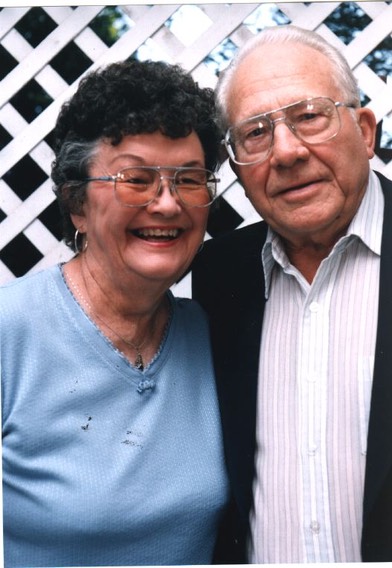
AUGUST 1998 (60th Anaverstiy )
***************************************************************************************************
NAOMI'S STORY
Information on this page was copied from a notebook kept by
Naomi's mother:
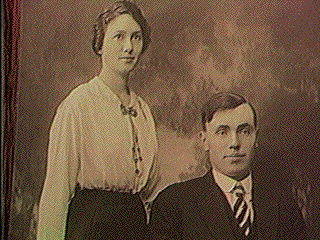
Pearl M. Huckins and Vernon Bethea (At left) were married April l8th, l9l7.
NAOMI PEARL BETHEA was born Sept. 2nd, l9l8.
We lived on Wing farm from April l8, l9l7, until Jan., l920.
Moved to Washougal, bought Mike Roly place. Sold it in April, l920.
Moved to Cascades, worked in camp.
Moved back to Washougal, July l920. Worked in saw mill and woolen mill until Dec. l8th, l920.
Moved to store at Mt. Pleasant. Left Mt. Pleasant, Aug. 6, l926
Moved to Cottage Grove, Or.
Aug. 7, l926. Left Cottage Grove Dec. 6, l927.
Moved to Goodrich, Idaho, arrived Dec. l4, l927. Left Goodrich August 3, l928.
Moved to Washougal. Left Washougal March l, l929.
Worked for Weger, Highland Park Poultry Ranch, Vashon. Worked for Therkelson and Beall.
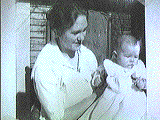
Pearl and Naomi, 1918
Moved to Ellisport, April l0, l930. Worked in store for Rodda, May lst, l930.
Bought Khuel place March 25, l934. Moved on place but still worked for Rodda at Center.
Started work for Kimmel, Vashon, Jan. 3, l937. Quit Kimmel Jan. 8, l938.
Started in business for ourselves at Weiss Surefine Market. Bought meat market. Opened Jan. 2, 1939.
1917 -1920, BIRTHPLACE
Naomi was born on the Wing place and was told that her Uncle Claude Bethea and his wife Georgia also lived there at the same time that Naomi and her folks did, so the brothers must have had the farm leased or rented. It was commonplace and expected in those days that family members cooperate with living accommodations and whatever else was needed to "jump start" young couples.. The Wing place was in the general area of Mount Pleasant, which is gone now, but in 1920 the general merchandise store and post office, that her folks bought, was known as Mount Pleasant. A country road wound up the north bank of the Columbia River and Mount Pleasant was about seven miles from Washougal, Washington. The store itself had been built in 1910 and had been owned for a short time by Naomi's grandfather, who sold to people named Brooks, who in turn sold to Naomi's father.
MT. PLEASANT STORE
An interesting little booklet, published by the SKAMANIA COUNTY HERITAGE , June, 1980, contains an article written by Naomi's mother about their life at Mount Pleasant.
Naomi's first memories are of living at the Mount Pleasant store, to which they moved when she was a little over three years old. The river bank was heavily timbered and steep. The railroad had carved its way upriver following rather closely the waters edge and the wagon road builders had made do with whatever right of way they could rescue from nature on the bank above the railroad. The store front faced the road and maybe one hundred feet down the bank was the railroad. The mighty Columbia itself was just a little ways further down the bank. The trains were not scheduled to stop at Mount Pleasant and did not stop unless there was a passenger to get off, or somebody was out in the middle of the track waving energetically. Naomi remembers having her own little red lantern to help flag the train down if anybody needed to board. The brake men would all wave and call to her. They would throw the mail sacks off of the moving train, and pick the outgoing mail from a hook near the track.
The wide spot in the road where the store sat had a hitch rack for one or two teams plus parking for a couple of automobiles, of which there weren't very many in 1920. In the store, which had living quarters above, Naomi's folks sold groceries, general merchandise of all kinds, feed for horses, and ran a cream station. In the picture (next page) the cream station is the small building on the right. It was a typical country store at that time. There was a gas pump outside; usually customers came with horses but once in a while an automobile did come along The pump had a long lever like handle to manually pump the gas from the underground storage tank into a 10 gallon tank on top of the pump. The container on top of the pump was made of glass so that you could see the level of the liquid. It was marked in increments of one gallon with a hash mark on the half gallon, so if 5 gallons were needed, you had to pump the gas up to the 5 gallon mark before inserting the hose into the customer's gas tank to let the gas drain into it.
These were good times for the Bethea family. Naomi has many happy memories of Mount Pleasant. She thinks her grandparents, Frank and Mattie Bethea, lived in one of the upstairs apartments for awhile. She was impressed and fascinated by the trains which went by on a daily basis. The river was close; family and neighborhood picnics were held on its banks while waiting for the fishermen to come in. Nets loaded with salmon and huge sturgeon would be dragged, with a team of horses, from the water and the catch loaded into pickup trucks.
Progress came in 1926. The demands made by the automobile explosion caused the state to build a new road. The following quote is taken directly from Pearl Bethea's (Naomi's mother) article entitled "MEMORIES OF THE STORE AT MOUNT PLEASANT":
, 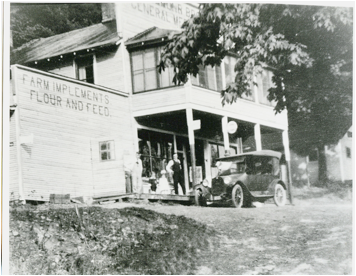
The Mt. Pleasant store, by passed and put out of business with new highway construction.
"The Mount Pleasant Store is gone now, but I still remember it and hope others do, too. In 1926 when they started to build the new Evergreen Highway over Cape Horn, they went over the hill back of the house, and by passed us. That meant they had to build a real deep fill, so with all their blasting and removal of dirt they ruined us.
The roofs were full of holes where the rocks hit and came through. Those big rocks even came into our living quarters and broke all our dishes.
The farmers couldn't come to trade with us any more because the blasting scared their horses and they would run away. So our customers began to drive to Washougal for their supplies.
We were paid very little for the damage done to the store building and the warehouse. They did put on a new roof, but that was all. We were thankful to be alive, but our business was gone. No more store."
Naomi says; "My folks knew there was going to be a blast so we went downstairs and stayed in the store. We could hear rocks rattling around upstairs. There was one as big as a football in the kitchen and broken dishes were all over the floor."
COTTAGE GROVE, OREGON
The Vernon Bethea family next moved to Cottage Grove, Oregon, and went into business again operating a cream station and route under a milk Company's franchise. This consisted of picking up cream from farms, testing for butterfat content, and
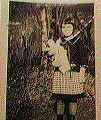
Age 4
shipping to the creamery. It was while they lived in Cottage Grove that Naomi got appendicitis and nearly died. She had been sick for about three days before the local Doctor was called, who diagonized appendicitis, and said "to the hospital, immediately." The hospital was 22 miles away, in Eugene, and her appendix broke before they got there, with resulting peritonitis Her surgeon said she would not have survived two hours longer. There were no anti-biotics in those days; so she was in the hospital 5 weeks and went home with drain tubes still in the wound. Finally getting better, she put on her roller skates and broke her right leg, followed by scarlettina and ring worm. That wasn't a very good year. (Naomi insists that she liked Cottage Grove.)
IDAHO 1927
Frank Bethea, (Naomi's grandfather) was now on a farm in Goodrich, Idaho (Near Weiser). His history was one of buying and selling various businesses and properties. including an automobile dealership as well as farms and ranches, without really operating any of them. He was in it for a sales profit. This time, according to Pearl, he had traded, sight unseen, for the Idaho ranch. When he got there, he didn't know what to do with it. He was also sick, supposedly. Hence, a distress call to son Vernon.
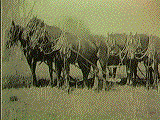
Six horse team Vernon used for plowing and heavy farmwork

Vernon cutting ice with one man crosscut saw in Idaho; for storage in the icehouse.
Naomi remembers arriving in Goodrich in the middle of winter. The farm was about five miles from town. Grampa Bethea met them at the station with a horse and sleigh and a big grin. Pearl was forever miffed about the sick business.
Naomi was in the 3rd grade, and the ground was covered with snow - deep snow. Riding to school in a horse drawn sleigh has its romantic appeal, but doing it every day, in zero or below zero weather, didn't turn out to be all that much fun. Even when the snow melted in the spring, getting to school was still a problem, due to the muddy road and a steep hill to go over. She did enjoy the horses and the rural life, which was good for her after the bad time with her appendicitis operation and subsequent weakness.
Vernon helped his "wheeler dealer" (Pearl's terminology) father through the winter, moving his family back to Washougal the next August, moving in with brother Fred. Measels and chicken pox conveniently came along so they were under quarantine until that passed. A friend and former neighbor, Wallace Weger, now was running a chicken ranch on Vashon Island, situated in Puget Sound in the northern part Washington state; so the next move was to Vashon Island. Quarantine detained his family so Vernon went alone to start. He worked a while on the poultry farm, clerked in grocery stores and eventually bought the Surefine Store and Meat Market in the little town of Vashon.
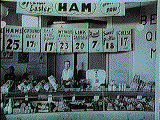
Vernon in his meat market
in the Surefine Store (1940).
VASHON ISLAND, 1929
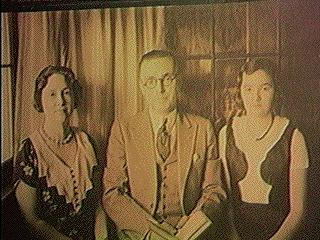
Pearl, Vernon, and Naomi, on Vashon, about 1935
Naomi finished elementary school on Vashon and graduated from the Vashon High School in the class of 1937. (This group has remained close and is still having annual reunions, in 1996). Naomi was headed for college at the University of Washington, to study nursing, and to make money for this she worked as assistant to the Islands dentist and as clerk at the Vashon drug store.
NAOMI'S GRANDPARENTS
All of Naomi's grandparents, on both sides, were early pioneers in the Clark County, Washington, area. In the 1850's and 60's, towns along the lower Columbia River were growing like mad due to logging, fishing, and the prospects of getting a farm in a Washington or Oregon valley. The severe drouth and depression in the 1850's prompted many to move west in search of a fresh start. As soon as the loggers finished, farmers came and took out the stumps to expose the fertile soil for their plows.
The Bethea family had migrated from Nebraska, traveling across country by train, as did thousands of emigrants lured by the prospect of a new life. One of the ways to move west at that time was to load all of your household goods into a railroad box car, in which you lived until arriving at your destination. This is how the Bethea family traveled.
Another way to come west was by covered wagon drawn by oxen or mules. Ida Blackburn, Naomi's maternal grandmother, and J. M. Huckins's future wife, arrived in this manner after traveling the Oregon trail. An obituary, published in the Vancouver newspaper after her death, March 23, 1948, described her life as follows:
A PIONEER PASSES
"Mrs. J. M. Huckins, one of the early pioneers of Clark County, passed away at St. Josephs Hospital, Vancouver, March 23rd, 1948. She was interred in the Washougal Cemetery March 26th.
h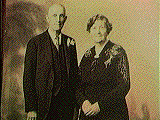
J. M. Huckins and Ida Blackburn Huckins, about 1947. His left hand had been cut off in a sawmill accident.
Mrs. Huckins was born in Atchison County , Missouri, March 3l. 1867 and while a small child moved to Furnas County, Nebraska, whence after the grasshopper plague and famine of the early 1880's, the family set out for the Pacific Northwest. The trek was made in true pioneer style, via covered wagon..The family arrived at Fort Vancouver in 1884; Ida L. Blackburn, the future Mrs. Huckins, being then seventeen years of age.
The Blackburn family, moving to the Burnt Creek area, north of Vancouver, Ida Blackburn met her future husband, J. M. Huckins, who was engaged in logging operations in that area. Mr Huckins had come to the Columbia River country in 1881, preceding his bride-to-be by three years. They were married August 21st, 1888, in the First Baptist Church of Vancouver, the Rev. P. H. Harper performing the ceremony.
The Huckins honeymoon consisted of a trip from Vancouver to Camas on the river steamer, "Traveler". Their residence in Camas, where Mr. Huckins was employed by the old Pitjock Paper Company, the couple returned to Vancouver, where their first child was born.
In 1890 , Mr. Huckins purchased the old Turner place in the Fir Grove community from H.J. Biddle, and Mrs. Huckins resided there until her death.
Mrs. Huckins was extremly popular throughout the county as was attested by a funeral cortege numbering upwards of 100 automobiles carrying sorrowing friends to graveside for the final farewell.
Surviving Mrs. Huckins are her husband, J. M. Huckins, and six children, namely, Edgar M. Huckins of Camas, Mrs. Bertha Lawson of Oak Park, Mrs. Pearl Bethea of Oakland, Calif., Mrs. Edith Reinseth of Seattle, Joe Huckins of Fir Grove, Mrs. Goldie Husby of Weir Park, and l3 grandchildren. Also surviving are two sisters, Mrs. Elizabeth Converse of Ridgefield, Wash., and Mrs. Mary Taylor of Redlands, Calif."
One of the experiences remembered and handed down by "Gramma" Huckins, from the covered wagon trip, concerned a little girl found along the trail and picked up by the Huckins wagon train. She was the only one left alive after an Indian raid. This didn't seem to be especially noteworthy but the fact that her hair was braided in four pleats instead of three was important, and the wagon train females all learned to braid "four way".
Naomi remembers being told that the family left the wagon train at The Dalles, Oregon, and that the Blackburns went from there by train to Junction City, and then to Fort Vancouver. The Dalles was an important junction of the Oregon trail, as the train came to there, and river boats, both upriver and downriver, had to turn around due to non-navigable rapids. (Bonneville Dam, built in the late 1930s, made a huge lake of the area.)
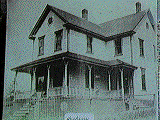
The Huckins house, which J. M. built with lumber from his own sawmill.
Joseph M. Huckins, Ida's future husband, a fiercely independent personality from Iowa, had arrived in the Vancouver area in 1881 He was 18 years old. He lived alone in his house after Ida died, until passing away in 1956. He continued to work his orchards and one man sawmill - - with one arm. About 1946, a couple of years before his wife died he had fallen in front of the saw, nearly severing his left arm at the wrist. Hurriedly driven to the hospital by his son, he announced to the Doctor upon arrival, "I've looked it over, Doc, it's no use. Take it off"

Frank E. Bethea and Mattie Abel Bethea at their golden wedding, 1931.
We think Frank and Mattie Bethea, Naomi's paternal grandparents, arrived at Fort Vancouver between 1897 and 1900. As mentioned in a foregoing page, they came by train with their possessions loaded in a box car, in which they lived for the journey. Vernon (Naomi's father), the youngest of the family, was a baby but we have found nothing written to establish an accurate date.for the journey. The family consisted of Frank E. Bethea, his wife Martha (Mattie) Abel Bethea, and four sons, John, Fred, Claude and Vernon.
Mattie Bethea was of Quaker descent with a goodly inheritance of the work ethic, thriftiness, and cleanliness associated with her lineage. Naomi remembers that when they lived together in Idaho, Grandmother Bethea would be up at four o'clock in the morning, clean house, make homemade ice cream, get breakfast and probably crochet for a while before anybody else got up. She was never idle for a moment, keeping her hands busy crocheting when not doing household tasks. The Ford coupe they owned in Idaho wore curtains she had crocheted Mattie never complained about what, Pearl thought, was a somewhat helter skelter life that came with her marriage to Frank Bethea.
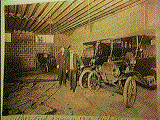
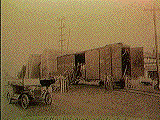
Frank Bethea loved to buy and sell properties and businesses; and his fortunes went up and down correspondingly. At one time he was co-owner of a Ford agency. It was a big event when a carload of new 1914 Fords arrivced.
*************************************************************************
BETHEA Genealogy
From a report left by Charles Vernon
Bethea
Naomi's father left a brief genealogical report that he had obtained from a cousin. The following handwritten note appeared at the top:
"The Betheas were French. The original spelling was Bethier. They left France during the French rebellion and migrated to Wales, then later to Virginia."
Initialed CVB. (Charles Vernon Bethea)
JOHN BETHEA:
Emigrated to Virginia in 1630. He had two sons: John and Triston.
JOHN (Jr.) had two sons: John and William.
WILLIAM had four sons: John, Goodman, Philip and Jesse.
GOODMAN had two sons: Philip and Jesse.
PHILIP had five sons: Goodman, William, Mathew, John (my grandfather) and Hix.
JOHN had two sons and two daughters: William, Frank, (my father), Elizabeth, and Florence.
FRANK EDGAR BETHEA, born Feb. 23, 1863, died Feb. 23, 1938. Married Martha (Mattie) Abel, born Oct. l, 1860, died March 27, 1948. They were married Wed., Dec. 21, 1881, at the home of her parents, William Abel, Clarks, Merric County, Nebraska. They had four sons:
JOHN WILLIAM, born 9/15/1882, died 4/30/1987, 3 children, 2 boys, one girl.
FRED CURTIS, born 12/1/1889, died 1/17/1984, one child, (daughter) Gladys
CLAUDE EDGAR, born,3/20/1892, died 5/8/1945, two children: son Donald, daughter Leah May
CHARLES VERNON, born 5/8/1897, died 5/30/1979, one child, daughter Naomi.
Vernon married Pearl Marguerite Huckins, (born 10/16/1896, died. 2/6/1990). Daughter, Naomi Pearl, born 9/2/1918.
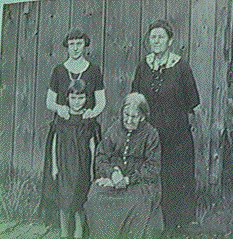
At left, 1925, Four generations , Naomi's great grandmother Blackburn, grand mother Huckins, mother Pearl Bethea, and Naomi.
1937
In the fall of 1937 Naomi entered the University of Washington, preparing to be a nurse. Through the University's placement service, she had been given a job within walking distance of the U., for which she got her room and board and $10.00 per month. All she had to do was cook, clean house, and baby sit. Sometimes she didn't have time to do homework. Tuition was $30.00 a quarter, so she still had to have minimum help from home.
BOB'S STORY
See the TOM & EMILY HUGHES, and LEWIS's stories for Bob's story up to the 1937-38 school year.
In the spring of l938 I was out of money, going to school at the University of Washington. Fortunately I had a job as house boy in a fraternity house for board and room. The l929 Ford Victoria had already been sold and that money barely got me to the end of the spring quarter. My friend from Fort Peck days, Jack Fremon, had already departed, at the end of the winter quarter, to Los Angeles and the University of Southern California. Also, the construction crew with which we had both worked in Fort Peck had been transferred to Los Angeles and was now engaged in levee construction on the Los Angeles River. Los Angeles looked good to me. But there was a problem.
BOB & NAOMI'S STORY
AT THE UNIVERSITY
The problem (brunette) took me over to Vashon Island to visit with her folks and herself for one last weekend. We had met at a mixer dance at the University which was held for incoming freshmen to get acquainted. Girls were lined up on one side of the hall and boys on the other. On signal both sides advanced across the hall and took a partner. The blond I was heading for ducked, and this brunette landed right in my arms.
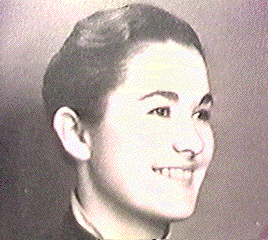
Brunette - 1938
Brunette was working for her room and board across the bridge in the Montlake district while studying to be a nurse. I asked her for a date the next week and she stood me up. Probably because this guy from Vashon, with a new Chev. got there first.
LOS ANGELES
Hitch hiking was my only option to get to Los Angeles, but that was no problem at that time. Everybody did it. The hazards and perils existing today hadn't been thought of yet. I had no trouble, upon arriving, in getting my old job back with the Corps of Engineers (Army) for whom I had worked in Fort Peck. It was supposed to be a five year job and I was started right out making $ll0.00 a month because of previous employment and experience. (Graduate engineers were taking first time jobs for about $95.00 a month.)
My job involved supervising and directing the placement of grout and concrete on the river banks, or levees. We were going through the Mexican district and could get lunch, including a bottle of beer, for twenty five cents. I especially remember being in charge, on night shift, of a grout crew, of mixed nationalities, who spent more time fighting than they did working. Those things haven't changed much.
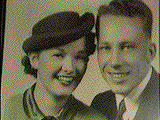
August, 1938
Being as I had such a rosy future, and was making more money than graduate engineers, I decided to get married and sent Naomi a diamond ring. That must have meant something because she wrote back that she would be right down. (Now she claims there had been a previous arrangement.) She arrived by train in due time. I always thought she could have got there quicker if she hadn't stopped off to celebrate her grandparents golden wedding and a wedding shower in Washougal. We were married August 28th, l938, in the Wilshire Wedding Chapel, Los Angeles. Jack Fremon was our best man.
We rented a little one room apartment with pull down bed and stove with oven. She tried to bake a lemon pie without much luck. Her rolling pin was an empty jar and any other equipment mostly wasn't there or was intended for some other purpose. She could wash clothes downstairs but there were no machines, just a scrub board. She has complained ever since that I had accumulated a bag full of dirty socks just waiting to get married.
My job lasted about a month after we got married. One morning the boss walked in and said that Congress had not appropriated any more money for that project. The whole job was shutting down, as of that moment, for an indefinite time.
We had saved some money, I don't remember how much. We figured we could wait a month before real trouble developed, and that I would look for temporary work. By watching the paper and talking to people, I learned where job opportunities would be the following day. Early in the morning, via streetcars and buses, I would try to arrive in time for a front line position. Jobs were scarce then, usually there were at least l000 applicants ahead of me, some had been there all night. The jobs were mostly for those with specialized skills, of which I had none. My chances were next to nil.
A month had passed and nothing had happened on re-opening the construction job, so we bought bus tickets for Montana with our last $20.00. The tickets were $l5.00 so we had $5.00 left. Can't remember much about that trip except that we rode through Reno on a street that had an overhead sign that said that Reno was the biggest little city in the west. That sign is was still there not long ago.
Dave and Bess Howells, my brother Ed's in-laws, took care of us when we arrived in Butte. They were very good to us and we stayed with them for a few days until Lewis could come in to get us. He took us to the home ranch in the Madison. By this time we were really grateful to have a family and friends to help us at a time like this. The next few months would do even more to illustrate how lucky we were.
l938 - l939
We stayed with Mother and Dad for only a short time on the ranch. Cousin John, who lived in Pony, had an incurable case of gold mining fever, and could get a job in any of the mines - due to a reputation as being a very good miner. In his spare time he prospected around in old mine dumps and early day workings. Any family member who wished could come along. I joined up, and we moved to Pony.
*****************************************
THE FOLLOWING HISTORICAL BRIEF APPEARED
IN THE "MADISONIAN”
Summer issue, 1991 of "Years Ago in Montana"
Pony, situated at the base of the Tobacco Root range, was named for a man called Tecumceh Smith, nicknamed "Pony". He had drifted into this territory from Alder Gulch. He prospected the creek that runs through Pony, which now bears his name.
In the fall of l875 rich quartz discoveries on Mineral Hill led to the opening of several mines. This created a stampede and close to one thousand people came. The rush soon subsided and by l878 the population numbered only one hundred.
There was a five stamp mill and a twenty stamp mill erected. In l872 the Isdell Mercantile was opened by Major Isdell. At one time fourteen clerks were employed. In the l880"s Isdell erected a new store of stone which still stands.
ln l875 the Reel House and the Pony Hotel were built.
In l889 the Northern Pacific Railroad started service to Pony from the mainline at Sappington. It was discontinued in l943 and the country road was built on the old railroad bed.
In l900 the town once again became very active due to the sale of the Elling & Morris properties to the Jentte Mining Co. This company built a hundred stamp mill which was never used due to the low grade ore.
As early as l864 the community had a minister and church was held in a tent. In l894 the Presbyterian Church was built, the Episcopal Church in l903 and the Catholic Church later.
In l920 a disastrous fire destroyed half the business district despite the efforts of the volunteer fire department and a fifty man bucket brigade.
During the peak years the population ranged between 2500 and 5000.
There were many businesses including a bank which was built in l902, and was finished with marble from Pennsylvania, a Creamery which took first place at the Montana State Fair for six years, two Chinese laundries, a Chinese restaurant, two insurance companies, a real estate office, hat shop, tailor shop, harness shop, jewelry store, bakery two general stores, butcher shop, livery stable, drug store, furniture store, blacksmith shop, two rooming houses, movie house, newspaper, assay office, lawyers, two dentists, three doctors, a library, power plant, telephone exchange, candy shop, mortuary, and twelve saloons, a band and a baseball team.
Note: Re stamp mills mentioned above; it was a process of pulverizing ore by dropping huge weights, sometimes air driven, in a stamping action. After pulverizing , the ore was treated to extract gold and silver.)
When Naomi and I moved to Pony in late l938, Mr. and Mrs. Bert Jackson owned a large part of what was left of the town. They lived in a big red brick type house which had been built many years earlier during "boom" times. It was a two story house with a full length porch and gables, as was popular with early day status type architecture. Upstairs was an apartment which we rented. The Jacksons also owned a number of houses which they rented out. My brother Ed lived in one of them with his family, and cousin John lived in another with his family. Most of the business places which had boomed in the gold mining era were no longer open, but quite a few of the old structures were intact and in fairly good shape. Later the Montana Historical Association became active in restoration and some of the most historical are being maintained in more or less original character.
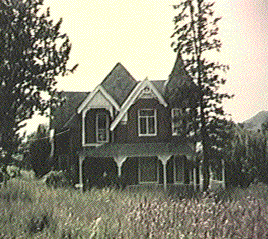
Jackson's House, we lived upstairs.
We were especially intrigued with a mansion which had been built on the hillside southeast of town. It also was solid brick, two or three stories, entrance steps both front and rear, solid hardwood floors throughout. Inside, the servants had their own stairway in back leading to the kitchen from their quarters, and the main big wide hardwood stairway for owners and guests was in the front living room area. The story we heard was that the people who built it had gone to Europe and never came back. Supposedly they had left it completely furnished, even to tableware. Everything of value had been stolen and removed by the time we first saw it, and all the rooms were bare. This house is now gone completely, sold and tore down for the bricks, with no clue to it's family or historical significance remaining.
There were only a few businesses open when we arrived there in the fall of l938. Joe Weber ran a grocery store and Alex Parsnik had a used car lot and garage. The post office was also a library with shelves of books along one wall. (Naomi thinks she got both "Gone With The Wind" and "Forever Amber" for the first time from this little library.) Some people lived in the old hotel and you could rent a room there for $2.00.
Joe Weber was bald and had two wigs for different occasions, one was for dancing and the other for business. They looked not at all alike. He was completely taken in by Naomi's youth and good looks and he loved to wait on her in his store but it got so embarrassing that we started to shop in Harrison or Bozeman. We went across the street to a dance in the school gym but she was afraid Joe was going to ask to dance with her so we went home. Joe always had a good supply of cheap, fresh meat in his store. That attraction came to an end when they caught him butchering at night in a neighboring rancher's field. He went to the slammer in Virginia City.
We bought our first car from Alex Parsnik. It was a l932 Ford V8, which, I believe, was the first year that Ford made the V8. It had two seats and two doors. The doors opened backwards from modern cars, being hinged on the rear so that they opened from the front. Yes, they did catch the wind and blow off, if opened by mistake while moving. The windshield was hinged at the top and you could push it open to let bugs and grasshoppers in. A grasshopper came through this opening one day at full speed and hit Naomi in the eye. She had a beautiful, swollen, black eye as a result.
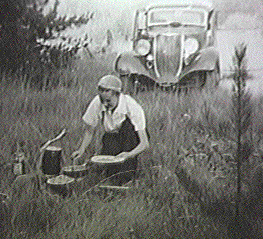
"Eating out", Summer,1939.
We used to drive this car to Bozeman once a month for $l5.00 worth of groceries, which would fill up the back seat to the roof, and would last a month.
Our wood supplier also went to the slammer! His antic was putting a dynamite bomb under the hotel because he suspected his wife was in there with another man. We owed him for wood and, on the day they took him away, he prevailed on the deputies to bring him by our house to collect. I was gone, Naomi was scared stiff, but she didn't have to go to jail with the wood cutter, so I guess she paid the bill.
Pony was interesting. A prospector's heaven, with hundreds of old mines and quartz ledges to look at, and sample.
PROSPECTOR'S RICHES
We lived in Jackson's upstairs apartment until the summer of l939 when the Jacksons wanted to take a vacation. Naomi was now sick all day, every day, with "morning sickness", and the Jacksons had a rule of no kids upstairs. However, they wanted us to stay in their place while they were gone and take care of it for them. They rented the upstairs to somebody else and by the time they returned one of their little rental houses would be available for us. I think the house rental was $l8.OO per month. I don't remember how much for the apartment, probably the same. They let us live downstairs for free while they were gone and that certainly was welcome, as our prospecting and mining endeavors didn't pay much. Lotteries hadn't been thought of yet but we had our own early day version going as every shovel full was a lottery ticket, with untold riches underneath.
Miners worked underground in teams of two. John offered to take me as his partner to the Boaz mine, where he was working, which was an offer I jumped at. If I could work with him for a while and learn mining, I, too, would be employable 'most anywhere'.
Winter was coming on so we wouldn't be able to do much prospecting until spring, but John, Uncle Bill, and brother Ed had leased and was doing some work in the Monitor mine which was in the middle of a very rich early day high-grade area. Several old mines were there, including the "Revenue," which had been named after the hill on which the ore had been discovered.
The Revenue Mine was famous for having produced some fantastically rich ore during its productive years. It ran for several years in the early l900's and employed quite a few men. My Uncle Ed was employed there about 190l or 1902. During rescue operations after some kind of an accident, he severely smoke damaged his lungs, dying of pneumonia in l908.
A friend of Dad's, Jess Frisbee, had worked in a mine near the Revenue during the boom years and knew that it had shut down without completely cleaning out one particular "stope". He kept the secret for 30 years until he got a chance to lease the old diggings. He and his two sons opened up the location and took out $75,000 each, it was said, in two weeks.
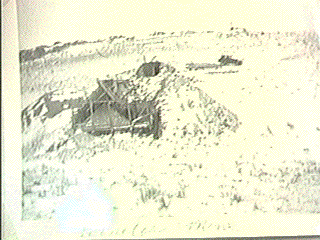
The old Monitor Mine, which had been worked in the early days, had only a waste dump and crumpled shaft house left when we worked it in 1939
The Monitor Mine adjoined the Revenue and Uncle Bill knew that ore had also been left in it, up near the surface. Being near the surface, the rock was all broken up, dangerous to work in, there was no solid ceiling, like it would have been farther down. The drifts (tunnels) were only big enough to crawl through on hands and knees. The mining procedure we had to use consisted of scraping and picking ore into a sack and dragging it back out to the entrance, carefully. Any unwise bump on the ceiling might bring the whole thing crashing down on your head. This is what they were doing when I joined the crew.
Real trouble developed only a few days later. I had learned enough to identify good ore by that time and had been given a spot of my own to clean out. Ed had another spot, also John and Uncle Bill. Lewis may have been outside sorting ore. All at once we heard this crash and rumble and a cry for help. Uncle Bill was buried. He was pinned down by a big rock. I don't know how John got him out of there but pretty quick he came out, dragging his Dad behind him. Bill was a tough old character and refused to go to the Dr. He crippled around for awhile, with what must have been broken ribs, but he didn't believe in laying around much.
We wanted to get rich, but not that badly, so we picked up our tools and sent what ore we had to the smelter.
There usually were three or four of us living in Pony and working at the Boaz. It was l8 or 20 miles to the mine, over by Norris. We took turns driving our cars. Often the roads were drifted with snow banks and we had to break trail. Sometimes this meant backing up and getting up enough speed to plow through. Other times we had to circle around in the fields, getting back to the road wherever possible. Our bosses understood the situation, however, and being a half hour late was no big deal.
BOAZ MINE, Rich high grade ore was discovered in 1938 when John and I worked there.
The Boaz Mine was where I saw some real "high-grade" gold ore. John and I had the job of driving a drift along a vein, or lead, of ore. The lead was only about two or three inches wide when we started. One day, after a blast, we went back in to discover that our lead was now filling up the complete face of the drift. It was unbelievably rich but vanished after two days work. For two days we abandoned the conventional drill, blast, muck out routine for the delicate procedure of picking down carefully onto a canvas, and loading by hand into a mine car. I never heard, exactly, how many ounces of gold and silver per ton that ore assayed, but they told us that we made enough money in two days to run the mine for a year. (They were employing about twenty-five men. Wages were $5.00 per day.)
DEC. 1939, A BABY ARRIVES.
Naomi had been very, very sick with all day morning sickness, for months. We decided it wasn't good for her to be alone all day so decided to go over and stay with the folks for a few days and I could drive to work from there. We didn't stay long. A few days before Christmas a nasty looking cloud came over the Norris hill. Dad said "You kids better get in my car and go to Bozeman, the Norris road is going to be blocked in a few hours". This was no joke, a good storm would block the roads at both ends of the valley, and they would stay blocked until some hardy soul took it upon himself to break it out. There was no snow removal equipment in that area.
I explained to Naomi that we could go to Bozeman and she could stay with Edith Fletcher, who used to be a neighbor and now lived in Bozeman. Naomi said she did not want to go to Bozeman and stay with strangers. Then she went out in the outhouse and bawled.
Anyway, we got in Dad's Dodge coupe, which was newer and better than our car, and left for Bozeman. The snow storm, along with freezing temperatures, came right in our faces. It had already been to Bozeman. The Norris hill was the easy part, from Norris on it was nothing but ice and fresh slippery snow on the road. We went the long way through Harrison and Three Forks as I knew the short cut through the Camp Creek Hills would do us in.
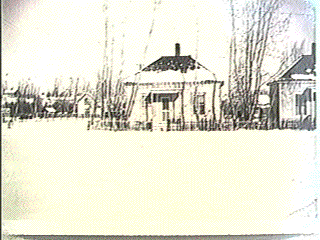
This little house would be our new home when we came home with a new baby
Cars were in the ditch on both sides of us so I drove down the middle of the road when I could find it. It was dark and snow flakes swirling in the headlights blinded us. Finally, we got to Bozeman, and checked into the hotel. That was the 21st of December.
Next morning we went to the Dr.'s office and he was more interested in my gold mining activities than he was in Naomi's baby project. She was hanging onto the chair with occasional contractions but it didn't bother him a bit. The contractions continued, off and on, all that day. When she felt up to it we would Christmas wish along the sidewalks. Towards evening I called the gold -fever-struck Doc and he said to take her to the hospital. I stayed with her for a while and developed a nasty nosebleed. The only one I ever had. We decided my nosebleed was due to exhaustion so I went back to the hotel to sleep for a while, instructing the desk clerk to be sure to call me when the phone call came. When the call came at 2:30 A.M., another clerk told them that I had checked out. I woke up only a little late for the big event. Baby Barbara had arrived Dec. 23rd, right on schedule.
We were now moved into the little four room rental house, in Pony, complete with a wood burning kitchen range, and a small but adequate heater in the living room. Furniture came with the house,
A new mother, in those days, had to stay in bed for ten days or two weeks. so I went back to work. The temperature was 30 below zero when I returned on the designated day to retrieve Naomi and her new baby.
Winter, 1939-'40
Our house was all warmed up for us when we got there. My folks had gone to Whitehall to pick up Naomi's mother, who had arrived by train from Seattle and Vashon, so they were waiting for us. Gramma B. had come for two weeks to take care of Naomi and the baby. It didn't quite work out that way because Gramma got a cold and flue. Naomi had to take care of both her and the baby.
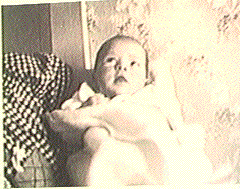
"Gramma B." rocks the new baby
It was bitter cold all the time Gramma B. was there. After she had gone we found her comb under the frost on the window sill. She was sure I was going to blow up the neighborhood because of the way I started the car on those cold mornings when the oil was so thick that the engine wouldn't turn over. Somebody had shown me how to fill a pail with wood ashes and pour just the right amount of kerosene in it so that it burned about one half hour when lighted. This made a neat little portable heater, when placed on the ground under the car's oil pan, would warm the oil effectively. By the time breakfast was finished, the car would start right up.
The left side of Naomi's face became paralyzed about two weeks after coming home from the hospital. Absolutely no movement or expression on that side. Lewis would run around to see the good side to tell what he called one sided jokes. Nobody we talked to had ever seen or heard of an affliction like this. Neither had the doctor in Three Forks, apparently, as he suggested it might be brain tumor. This really scared us so we got to our Bozeman doctor as soon as possible. He just laughed, asked about mining, said it was Bell Palsy, said it would go away in a few days and gave her some medicine. It went away in a few days.
SPRING, 1940, NORWEGIAN CREEK , MORE RICHES
It was late March or early April when we moved out to Norwegian Creek. Snow banks were still piled up but the weather was warm and the snow banks disappeared in a few days. The old log house we were moving into wasn't in very good shape but we made it livable with a little fixing. We plugged the cracks, boarded up a window or two, built a fire in the old kitchen range, which worked pretty well in spite of having a hole in the oven, and settled in for what was to be our home for a few months. The old cabin had not been used for I don't know how long, except by mice which were still there. I think that it was probably the first substantial house built in that area during the homesteading era. It was what you might call dilapidated, but had one very redeeming feature - free rent. Also, it was close to our newest prospect hole down the creek a half mile.
(Note: Norwegian Creek is about 8 miles south of Pony. Preacher's Gulch runs into it about a mile from where the road used to be. There is now no access to the cabin area.)
Dixie (then Barbara) was three months old so there was a diaper washing problem. We had an electric washing machine, but no electricity. I don't know where the gas engine came from, but we hooked it up with a V belt to the washer and it worked fine. The dryer consisted of two wringer rolls with hand crank plus a clothes line outside.
A spring for water was outside and down the hill somewhat. When we needed water we had to take pails and lug it up to the house. Enough water for diaper washing required extra effort. Lewis and I would take a galvanized tub and a couple of buckets down to the spring, before leaving for work, and carry them full back up to where the washing machine was under a tree. Naomi was scared to touch the thing so we would start the engine with only enough gas in it to do the wash and it would shut off by itself.
She would have her wash done right after breakfast and would complain that there were no neighbors to see how early she got it on the line. I forgot to mention that she had to heat water on the stove..
The only neighbors were a German couple who lived up the creek about a mile. Since World War 1 was of fairly recent memory, they were quite naturally under a great deal of suspicion, and since the lady spoke no English and never came out of the hills, we hadn't really gone out of our way to be friendly. The man was usually unshaven and dressed in whatever was handy. One day he stuck his head in the window of our cabin, scaring the wits out of Naomi who was there alone with the baby. He was harmless, of course, of good intentions. and only wanted to arrange a ride with me to somewhere or other. He had no car and would walk the eight or nine miles to Pony for mail and groceries. A rap on the door would have startled her anyway but to look up and see a hairy face in the window really did it.
Our "discovery" down the creek consisted of a very old prospect hole which we felt had been overlooked in the early days when the old timers were interested only in "high-grade" ore. We decided to sink a shaft down on a very faint lead which was sure to open up and make us all unbelievably rich. "We" consisted of cousin John, brother Lewis, and myself. Brother Ed had moved back to McAllister to take up ranching. John was in charge of the crew, due to having had mining experience and much natural ability. The lead we were going to follow was said to be about like a pencil streak, widening in spots to a whole pencil's thickness. Our homemade, preliminary, assay work (consisting of pounded up ore from the waste dump sloshed around in a gold pan) showed enough color that we decided that this was it, all we had to do was to get down to where that first big pocket of undiscovered high-grade lay. Some of the old timers had even told John that there had to be a bonanza down there " if you followed it far enough."
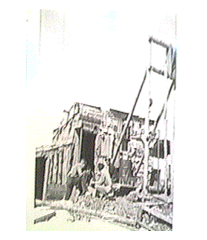
Our Norweigian Creek mine had an old gallus frame and a tumble down shaft house. We hoisted debris and leavings out of the shaft; sorted it, and the waste dump, for ore rich enough to ship to the smelter.
First we had to clean out the debris and waste left by the old-timers in the shaft they had dug straight down along the quartz lead. To do this we rigged an old Chevy engine with various pulleys and belts for a makeshift hoist. One of us would get in the hole and "muck" into a barrel which would be hoisted up and dumped out of the way on top. Eventually we took enough stuff out so that we could clean off and examine our lead, or vein, of gold and silver bearing ore. It was hard to find but John decided it was encouraging enough to drill and blast, so we did.
The drilling had to be done by hand with a short handled two pound hammer called a "single jack". A "double jack" was a long handled eight pound hammer but could not be used in the shaft because of lack of room. The single jack had a leather thong loop which went around your wrist and, if you became adept enough, you could release your grip on the handle on the down stroke and whip the head of the hammer head down on top of the drill, for additional impact force, without jarring your hand. The drills were of tempered steel with hand forged star points. John had learned how to sharpen steel from his Dad. They had to be tempered just right so as to not break or flatten. Uncle Bill was an expert, having worked in the early day gold mines The drills were of various lengths, short for starting holes and replaced with longer ones as the hole got deeper. Each time, after hitting the drill, you had to lift the drill with the other hand and turn it slightly in order to break out a clean hole down which dynamite sticks could be tamped. Every once in a while it was necessary to pull the drill out of the hole and pour in a little water in order to keep down the dust and perhaps make it drill easier in the solid granite. Drilling was hard work, deserving of daily discussions of making or stealing a compressor so that we could graduate to a jackhammer. John claimed we could take a V8 engine, run it on four cylinders and use the other four to compress air. We never did get to explore that idea as even the problem of getting a used V8 was too much for our pocket book
We blasted one afternoon after finally drilling our holes as deep as John wanted, which was about 24 inches. We had drilled enough holes to go around the perimeter of our four foot shaft opening, plus several holes in the center to break the rock into smaller chunks and to make sure it all came out. Two center holes were drilled deeper and on a slant so as to remove a core area for the other holes to blast into, thus less powder was needed in the outside holes. Caps (detonators) were fitted to the fuses and inserted in the ends of dynamite sticks. Holes for the caps and fuses were punched down into ends of the dynamite with a 40 penny spike. These sticks, fitted with fuses, would go into the hole last so as to leave the fuse hanging out of the hole. Ends of the fuse were split with a jack knife, exposing the flammable center part for lighting. The fuses were cut to different lengths so as to make the explosions come in sequence. The two center holes were supposed to go off one and two, with the rest going progressively around the face. John lit the fuses one after another, in the desired sequence, with the flame from his carbide lamp, and we scurried out of there to wait for our fortunes to be uncovered.
I think we had nine holes and theoretically we should hear nine explosions. A miner's dilemma appears if you don't count enough explosions. What has happened? Did two go off together or, heaven forbid, has there been a misfire? A misfire was, and still is, dangerous business. Many a workman has been killed by going back to the blast area too soon, or by trying to deactivate a misfire. However, we were lucky, we counted all nine explosions.
The hole would be full of headache causing smoke, or course, after the blast so we couldn't "muck out" until morning. It took nearly all day to hoist and dump all of our broken rock, and clean up the waste so that we could examine the face of our gold mine. All night we had these dreams of great wealth which was ours due to the mother lode we had just uncovered and was lying under that pile of rubble. The previous evening's discussions were all about what to buy first. We needed so many things it was hard to choose.
Finally we had all the rubble and waste rock out and could see the face cleanly. Guess what? An exhaustive inspection revealed absolutely no trace of our lead. It was gone completely. At this point we ruefully remembered the visitor who had come by earlier and offered to buy our lease for $l50.00. John and I were glad that we had not given up our jobs at the Boaz mine to which we were commuting five days a week. Lewis was still recuperating from his accident at Fort Peck and had some income from Industrial Insurance.
All was not lost however. The old-timers who had originally mined this area had been concerned exclusively with "high-grade". This meant that their waste dumps contained sorted out ore which, in their time, did not carry enough gold to be valuable to them. Much of what they had thrown away was now worth shipping to the smelter due to the increase in the price of gold. I believe it had gone up from $l2.00 an ounce to either $32.00 or $48.00, I don't remember which.
The nation had gone off of the gold standard, (meaning that every dollar printed by the treasury had to be backed up with one dollar's worth of gold in the governments storage vaults) when Franklin Roosevelt was elected in 1932, but the price was not yet free to rise and fall with market demand. Every once in a while President Roosevelt and Congress would increase the regulated price so as to bring in more gold, as there was still strong sentiment to keep enough gold in Fort Knox to back up most of the issued currency. They were printing money like mad to combat the effects of the depression and increases in the price of gold were coming in rapid succession.
We carefully sorted and screened the waste dump of the hole we had worked, plus a number of the old mine dumps in the area. We had made a truck out of Lewis's old Buick Sedan which would be used to haul the good stuff to the smelter in Helena. The smelter would weigh the load, assay it for gold and silver content, and give us a check. This activity really didn't pay very well but at least we could work up in the fresh air instead of underground.
Lewis stayed with us most of the time while we lived at the cabin since he was the truck driver and would take our load to Helena daytime's while John and I worked at the Boaz. One evening he parked the loaded truck by the cabin at the top of the grade going down the canyon. It had to be coasted down the hill to start, of course. It also had no brakes, and had to have wheel blocks in place. We were inside having dinner when we heard the crash and rumble. You guessed it, our ore was scattered all over the hillside and the truck was upside down at the bottom of the canyon.
Naomi's folks had written to the effect that Boeing was expanding like mad, hiring lots of help, and it looked like employment for a long time. England and Germany were already at war and there was no way we could keep out of it. Prospecting for gold had lost quite a bit of its attraction. It seemed to be time to go.
BACK TO WASHINGTON
Our '32 Ford was pretty well used up by then. It had fought snow drifts all winter, bounced through fields of rocks and irrigation ditches, and had really given service way beyond the purchase price of $200.00. It smelled like kerosene and needed new tires. The kerosene smell came from not being able to afford antifreeze and falling for some body's story that kerosene worked fine in the radiator, and obviously wouldn't freeze. They forgot to tell me that kerosene would rot the hoses and spill the stuff all over a hot engine. Therefore, when we left for Washington, we were traveling in a newer model Chevrolet, two door, two seat sedan. Dixie came to Washington in a cardboard box for a crib and on top of rolled up bedding and our household goods in the back seat.
NEW JOB
When I went to work at Boeing in 1940 their facilities consisted of Plant 1 and the Old Red Barn, by the river, where William Boeing had started the company. Plant 1 was engaged in the B17 (flying fortress) production. The last Clipper Ship, in a contract for six, for Pan American Airways was being finished in the Red Barn, and I was assigned to work there. My beginning salary was $90.00 a month, which was to be increased to $105.00 after a training period, which I think was to be one month.
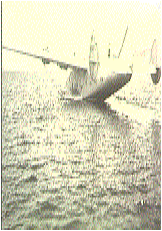
The last clipper ship ever built takes off from Lake Washington
Naomi's folks had just taken over the meat market at the Surefine Store in Vashon and I helped with that a little bit, (such as cleaning 30 chickens in one day) while waiting for a job. The Boeing Company had promised me work as soon as I got a birth certificate and that took a few weeks, so it was probably July when we rented Deb Herrington's house on Vashon Island's north end and started commuting to Boeing via ferry boat and car.
My first job consisted of weighing everything that was taken on board, or taken off, the Clipper under construction. (The training for this job took about l5 minutes but I had to wait a month for the raise.) The Clipper was an immense, four engine flying boat and the final one of a contract of six was being assembled when I went to work.
The highlight of this job was when the ship was ready to test and taken out to Lake Washington for the test flying. I was put on the accompanying barge with my scales and spent several weeks on the water recording the weight of everything that went in or out of the ship. I especially remember how pleasant the test pilot, (I think his name was Eddie Allen) was to me, probably to everybody. He always stopped and looked at my book and talked a little.
Plant two was being constructed at a furious pace. We were not yet in the war but Britain had a dire need for the Bl7 bomber. We soon were in the war also and additional expansion was then needed to satisfy our own Air Force requirements My job with the flying boats came to a conclusion and I was assigned to Magnetic Inspection (Magnaflux) in Plant Two. Due to the terrific expansion, I barely had time to learn what I was doing before being made a shift supervisor for my little dept. Boeing flew me to Stanford University, my first airline flight, for a two week course in Supervision.
1941, ANOTHER BABY
Meanwhile, Naomi was busy with another baby project which reached the critical stage in early August. We decided to go in to Ballard and stay until the baby came with Naomi's aunt and Uncle, Ed and Edith Reinseth. They had two small daughters, Pat and Delores, who could help with baby sitting Barbara (Dixie) while I was at work. Contraction Day came on schedule, the evening of August 3rd, and I took Naomi to St. Lukes Hospital in the University District where Dr. Jensen delivered Robert V. (whom Gramp promptly named "Bud") early in the morning of August 4th.
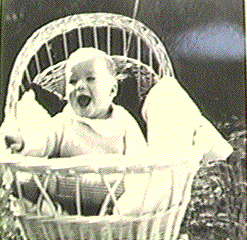
Robert Vernon Hughes,6 months old
This was not a pretty baby like his sister had been. In fact, I remember being a little bit startled at first glance but the nurse assured me it would only take a few days for him to look like a regular baby. Naomi checked to see if he had the right number of fingers and toes and pronounced him o.k. to keep. Also, he was paid for in full, due to the the King Co. Medical Program carried by Boeing. We still owed $50.00 on the baby born in Montana and were paying for her at the rate of five dollars per month.
PEARL HARBOR DAY, DEC. 7th,. 194l.
I guess this was the scariest day I have ever experienced in my lifetime. I'm sure the inland states did not panic to the degree that we did here on the west coast. Those of us working at the Boeing factory felt especially vulnerable and target attractive due to the importance of the Bl7 in the war effort. Officially, we had not been in the war, but now on this day, we were, we thought, right in the middle of it. The nearby Navy Yard at Bremerton added to our prime target area status and to the assumption that it would be only a matter of time until we were bombed. Pearl Harbor was not that far away, and rumors went through the plant like wildfire. At one point, bombers had been spotted only l5 minutes off the coast and everybody knew that there were only about three fighters to defend us. Some of the "experts" said that Pearl Harbor was a diversionary action and the main Japanese fleet was off our shore. It was a difficult day.
However, we didn't get bombed and the problem of commuting under blackout conditions came up. Some workers decided to stay all night at the plant but I and the fuselage painter, with whom I was riding that week, decided to go home with no headlights. Fortunately, there was enough moonlight that we made it to the ferry dock and were guided onto the boat by flickers from a flashlight.
Being Sunday (we were working 7 days a week, sometime l0 hours). Naomi had gone with the kids up to her folks place and spent the day. They had not listened to the radio or talked to anybody all day so knew nothing of what had happened. Naomi had turned on every light in the house waiting for me to come home. I was aghast, coming up the hill to realize that probably the only light on the whole of Vashon Island was my house. We promptly doused the lights and turned on the radio. Next day we had to get black material with which to cover necessary windows.
It took only a few days to ascertain that the Japanese fleet was not off our shore and the blackout was lifted conditionally. Congress had declared war on both Japan and Germany and we went on full scale Emergency Conditions. Naomi helped on preparing the Island Emergency Hospital and trained for nurses aid work. I studied aircraft identification and got up at 2 o'clock in the mornings so as to man a lookout for a couple of hours before going to work at Boeing.
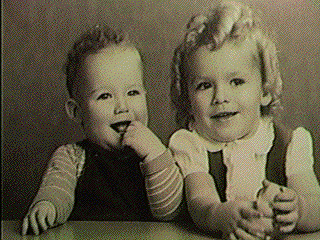
We started to notice that our daughter had an eye problem.
Tension eased gradually and we became more relaxed even though work intensity increased under wartime conditions. At first we worked 60 to 70 hours a week, which was cut to seven 8 hour shifts as soon as there was room and facilities for more workers. We changed shifts every two weeks. Deb had a little cabin, near our house, which I slept in days when on graveyard shift. (Those two little kids were just as noisy then as they were after they grew up.)
It was gratifying to see the Bl7s, so badly needed in Europe, rolling out of the big doors at Plant Two and across the road to be test flown. A plant rumor went around that a prototype for a bigger and better bomber with much farther range, the B29, was being built in a highly secret location.
FRANKLIN DELANO ROOSEVELT
George Washington and Abe Lincoln only had one crisis each to handle. Roosevelt had two, the Great Depression and World War Two. To me, he was an inspirational leader and did a superb job of handling two national emergencies. Even though the depression may never have been historically classified as a national emergency, a lot of us who were in it thought differently - starving to death had as definite an air of finality to it as death by any other means.
Roosevelt led the country through both those very difficult situations against sometimes bitter opposition. I was old enough to vote for his second term in l936 and a third term in l940 and a fourth term in l944. The war was in full swing and "don't change horses in midstream" was a powerful slogan. The day of his death, April 12, 1945, was almost another panic day as we had only heard rumors of his sickness. A fellow named Truman was now president and we had barely heard of him.
I have never thought that Roosevelt intended to launch this country on the road to Socialism. Something needed to be done, because of the depression, when he became president and he did it. The war came along to solidify government control. He did not plan to have a war, it just happened to him. I think it unfair for him to be blamed (or credited), that his emergency survival spending programs became the cornerstones for a permanent welfare state. I don't think he envisioned a dependency culture, but the "free lunch" syndrome certainly became a popular agenda for politicians.
A big problem, for the west coast, came with Pearl Harbor. There were thousands of first and second generation Japanese living all the way from the Mexican border to Canada. Most of them were hard working, industrious people in good stead with their neighborhoods. Some of the older generation had not yet attained citizenship, but I doubt there were very many that were not working at it. The history revisionists have had their crack at what happened to those people, but to understand it, you had to experience the panic and near hysteria of Pearl Harbor day.
It was well known that many of the older Japanese had short wave radios and that they listened to broadcasts from their homeland. Some had transmitters. Were there spies in our midst? How many of these people would be on the beach lighting beacons to guide enemy bombers? Their Japanese schools on Saturdays had not been monitored to see what was taught. People of German descent had been well screened since World War l, nobody had felt it necessary to look closely at the Japanese.
Orders came down from the president for them to immediately get ready and meet at various departure points and they would be interned in concentration camps for the duration. I don't think there were any exceptions. Local police forces were empowered to enforce the orders, and this they did promptly; with such bitter feelings building over the treachery of Pearl Harbor, bad trouble could come at any moment. This action, much criticized later, probably saved the internees from a worse fate. Just imagine the turmoil had they been allowed to live in our midst.
One of Vashon Island's biggest and best strawberry growers was Japanese, and he had to let his holdings go to the first opportunist that came along. Many other injustices occurred because of the dislocation, but those in my circle were not wasting sympathy, we were too busy building machines with which to kill their brothers.
SAN FRANCISCO, 1943 - 1947.
My job at Boeing involved inspection of critical steel parts, mostly motor mounts and machine gun supports, that went into the bombers. This work was closely supervised by the Air Force and one day the Air Force Inspector told me to go see a small firm in downtown Seattle that was doing some work for the Air Force. It turned out that the little company, Industrial X-Ray Engineers, had a contract in San Francisco to do some aircraft parts inspection and they had no certified Air Force Inspector. It seems I had been picked to be their man, and in war time, who argued?
Since trained help was vital to the war effort, measures to prevent labor pirating had been established, prohibiting defense workers from moving around from job to job. I don't know what happened to that regulation in my case because it was not long before I landed (my second airline trip) in San Francisco to start a new job, find someplace to live, and move my family. Although not being signed up for military service, war workers also did as they were told.
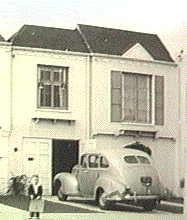
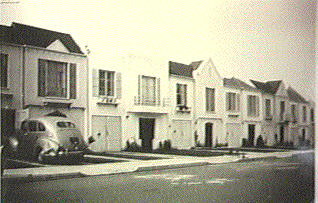
Wartime housing was thrown up in a hurry. Our house in San Francisco was the one with the 1938 Hudson-Terraplane parked in front.
Starting the job was easy. Finding a place for my family was not. San Francisco was a shipbuilding center with Henry Kaiser turning out his baby flattops, the Navy Yard was repairing battle damaged ships, several plants had hastily converted to make aircraft parts, and thousands of military people went in and out of the port every day. San Francisco was a hub of activity servicing the intensifying war in the Pacific. Defense workers were streaming into San Francisco from everywhere, all of them looking for a place to live.

Our house was between Ortega and Norweiga Sts., on 3lst Ave., I think the number was 1883.
Wartime housing was being constructed at a furious pace and the Airforce Inspector pointed me towards a development out in the Sunset Beach district of San Francisco which had just been opened for occupancy. For $500.00 down, defense workers could get into a two bedroom apartment like housing unit built on the sand looking out over the Pacific Ocean. Each house was attached to the one next to it with only a double wall separating them. Thus, a whole block was contructed as one building, which certainly facilitated construction as well as providing foundation stability on the sand. It also made it easy overhear to hear your neighbor's differences of opinion.
Although extremely doubtful about investing in "war-time" housing, there was no other choice, I made the down payment and flew back to Seattle to move my family, arriving in time to spend Christmas, 1943, at home on Vashon. The problem now was to get moved to San Francisco as quickly as possible, so we spent the holidays packing our stuff and arranging for shipping Our departure by car was made shortly after New Years Day. Our stuff didn't get there for several days after we did, so my boss and wife put up with us in their house in the Piedmont district until we could get into our place.

Grampa and Gramma Bethea soon arrived in San Francisco and one of Gramp's first jobs was to build swings in the backyard for the kids.
It turned out to be much better than I thought it would be. We had a nice big back yard with nothing but sand for the kids to play in, a good view of the ocean, with fog coming in every afternoon at 3'o clock, good neighbors; everybody knew everybody else because we had all moved in at the same time. Even though being hastily constructed in war time, the district greatly improved in value over the years and we doubled our money when we sold in 1947.
Even under the stress of wartime, we had fun in San Fancisco. It was a fabulous place to eat out. You could go to a different restaurant every night for a year and not cover all the good ones. Numerous friends in the military would be shipping in or out of the port to and from unknown destinations, people from all over were there engaged in war work. We knew and enjoyed our neighbors; we had all moved in at the same time, so there was no "new kid on the block"syndrome. San Francisco was exciting. Had an opportunity come up to make a living there after the war, we probably would have remained .

The kids were not yet school age when we moved to San Francisco.
Greene's eye hospital in San Francisco was recognized widely for its success in newly developed procedures for correcting crossed eyes. This fact had been prominent in our thoughts when "offered" the opportunity to move there, because Barbara (Dixie)had one very badly crossed eye and the other one turned in slightly. We took her immediately to Greene's, who managed to straighten one eye with exercise and treatment, but eventually had to operate to straighten the other one. Naomi spent an entire year riding the bus and streetcar three times a week, from the Sunset district to Greene's eye hospital in downtown San Francisco. Sometimes the next door neighbor, Mrs. "Mac" (McDermott) would keep two year old Bobby but usually it meant a day long trip with both youngsters.

About 1946
THE BOMB AND V. J. DAY
Germany surrendered in May, 1945, one month after the death of President Roosevelt. His successor, Harry Truman, proved himself to be equal to the task of being president and made a decision that has probably had as much impact on world affairs as any other single decision in history. He decided to use the atomic bomb. The "bomb" had been developed in absolute secrecy as far as the general public was concerned. We had been frightened several times during the course of the war by rumors that the Germans were developing a terrible new weapon capable of devastating an entire city with a single blast, and that they would soon have their V (Vengeance Flying Rocket) series developed to where it could hit New York and Washington D.C. Our own involvement in such a project was the best kept secret of the war.
Two Japanese cities, Hiroshima and Nagasaki, were leveled by atomic bombs August 6th and August 8th, 1945. Japan surrendered unconditionally a few days later and the war ended in a brief ceremony, September 2, 1945, with General MacArthur accepting Japan's capitulation on board the battleship Missouri.
An unbelievable celebration erupted all over the nation. Naomi and I heard on the radio that crowds of people were gathering on Market Street; her folks were there to baby sit, so we decided to drive down and see the fun. Traffic made it impossible to go a straight route downtown so we circled out around through the Mission district and finally gained a parking place near enough to Market Street that we could walk. Market Street was a mass of humanity, surging first one way and then another. At first it was the noise of a joyous celebration, with only the yells and cheers of boisterous relief that the war was over. People hugged and kissed total strangers, shopkeepers handed out gifts and treats, a local stripper climbed to the top of a statue and put on her act; for a while it was just fun. Then it started to get ugly, too much booze and beer had been handed out, so with a few ringleaders, vandals started breaking shop windows, we watched them try to tip over a street car, and the joyous sounds of celebration turned into the frightening rumble of a mob. Naomi and I got out of there and went home with mixed feelings. The war was over, we understood and joined in the celebration, but we never understood why it turned into anger and violence.
Franklyn Roosevelt didn't live to see the victory to which he had led the nation. The history revisionists are trying to paint Truman as some kind of a hard hearted, cruel monster for having made the decision to drop the bomb. It must be remembered that Roosevelt made the decision to build it and supported development l00%. Would he have used it had he lived? Of course he would. Would Japan or Germany used it if they had it? Of course. Bleeding heart liberalism wasn't popular yet. Harry Truman used the tools he had to end a war we didn't ask for, didn't want, and didn't start. Any other president would do the same in those same circumstance; he would have been considered derilect of duty had he not done it. Does historical ignorance justify the revisionist mindset that villifies patriotism?
**********************************************
WHAT NOW?
The war was over, now what would we do? The joy and relief that the war's end brought was soon tinged with apprehension. Thousands upon thousands of war workers suddenly had no job and the conversion to peacetime activities was going to take some time. Would it be our fate to go back to the depression conditions that existed before the war started. Unanswered questions were everywhere.
READY CUT PLEASURE CRAFT. (My First Attempt at a Business of My Own)
The need for lightweight, high speed, torpedo boats, (P. T. Boats) which were used against Japanese shipping in the South Pacific, accelerated development of methods and materials for construction of boats made out of plywood. Although plywood had been in use for years, it was not practical as a boat building material until development of a glue which could withstand being in water and would hold leaktight. Marine glue was only one of the many furious developments of World War ll that found use in the peacetime world. To me, it was just as important as Atomic Energy.
A marine engineer in Stamford, Connecticut, had designed a series of boat models made from the newly developed marine plywood. His idea was to sell kits of pre-cut parts for the customer who wanted to build his own boat but did not have the tools and know how to work from the ground up. With good instructions almost anybody could assemble pre-cut parts. It sounded like a good idea to me!
***************************************************
PLACES WE LIVED
1. Apartment in Glendale, California, August l938, until probably middle of October.
2. Pony, Montana, upstairs apartment, and downstairs while they
were gone, in Jackson house. November l938 until December, 1939.
3. Pony, Montana, four room house rented from Jackson. December of l939 to May of l940.
4. Norwegian Creek, old log house on Preacher's Gulch. Address still Pony. May and June, l940.
5. Vashon, Washington. June l940. Stayed with Bethea's for maybe a month waiting for employment at Boeing. Rented house on north end of Vashon, owned by Debb Herrington. Stayed there until transferred to San Francisco in January, l943.
6. San Francisco, California, January, l943. Bought house on 3lst Ave. between Ortega and Noriega, Sunset District. Fourth house from Ortega. Lived there until June, 1947.
7. Tulsa, Oklahoma, l223 South Urbana,August l947, for about two years and moved to 555 South Sandusky, until summer, l954.
8. Seattle, Washington, Lived briefly in rented house on Lake Washington and also for a year in a rented house in Seattle's north end.
9. l3th N.W., Seattle, Washington, Innis Arden District. 1955/57.
l0. Built house in Uplake Terrace, lived there for about three years, l957 / l960.
ll Rented apartment in Ballard for year.
l2. Bought house in Bothell, probably early l962.
l3. Built house in Happy Valley, Sequim, l969/l979.
14. Mobile Home, Burley (Port Orchard), Washington, l979 / l994.
15. Sold mobile home in l988, full timed in trailers until August, l994. Portion of property at Burley to park trailer on was retained until 1994.
16 Enumclaw, Washington, June l994